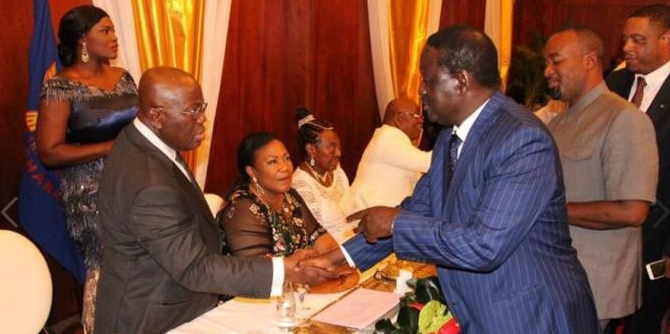LSE’s McDonald Lewanika discusses the possibilities and prospects of an opposition coalition in the upcoming presidential elections in Zimbabwe in 2018 through analysis of the 2008 and 2013 polls and examines the insights they might hold for the future success of an opposition coalition.
This article is part of our African Elections series.
The need for a “grand” coalition of opposition forces in Zimbabwe has been one of the major talking points and proposed solutions for defeating incumbent President Robert Mugabe at elections scheduled in 2018. The surprise 2016 success of a seven-party Gambian opposition coalition in unseating long-term President Yahya Jammeh, poured fuel on this already salient idea within the opposition in Zimbabwe, capturing the imagination of an estimated 45 per cent of Zimbabweans (mostly urban opposition supporters) exasperated by Mugabe and his ZANU-PF’s 37 years in power. This excellent idea is well supported by evidence of opposition coalition successes from across the African continent over the last 15 years as exemplified by Kenya (post-2002), Senegal (2000 and 2012), Benin (2006), Nigeria (2015), and Lesotho (2012 and 2015). From the evidence, it appears that opposition coalitions stand a good chance of overcoming the advantage of incumbency.
However, while the prospect of an opposition coalition in Zimbabwe is laudable, it is not the condition sine qua non of ZANU-PF’s demise. When the commentariat give examples of successful opposition coalitions, they pay scant attention to the contingent nature of such coalitions and fundamental differences in electoral systems, political practice, and culture between Zimbabwe and these examples. For instance, The Gambia has a single round presidential election system while Zimbabwe has a two-round presidential election, which makes the winning calculus in both countries different. While Kenya and Senegal have a two-round presidential election system like Zimbabwe, they have rich traditions of coalition politics based on ethnicity (Kenya) and ideology (Senegal). So, while the general principle that opposition coalitions increase chances of regime change is accepted, the differences in electoral systems and political culture should point to contingent and idiosyncratic factors that have so far evaded opposition coalition talk in Zimbabwe.

Photo Credit: The Citizen Newspaper
In Zimbabwe, the principal argument in support of an opposition bloc is that a variety of opposing parties rally their supporters behind a single candidate and that the total votes would be sufficient to defeat ZANU-PF. This weighting also informs the value placed on possible coalition partners by key supporters of the biggest opposition party, MDC-T, and some of its officials. While this thinking is respectable, it is steeped either in a romanticisation of the 2008 election (when the combined opposition votes [56 per cent] would have trumped Robert Mugabe and prevented a run-off) or a denial of the reality of the 2013 results, or both. The 2013 harmonised election result, in which the combined opposition vote was less than Mugabe’s 61.09 per cent, should have poured cold water on the coalition talk based on the same simple logic that had spurred it.
The romanticisation of the 2008 results, while ignoring 2013 electoral returns betrays un-strategic selective amnesia on the part of Zimbabwe’s opposition. The opposition tends to look at the political field with rose-tinted glasses with an over-reliance on favourable data and information regardless of its age. This approach was in evidence in 2012, and recently in 2017 regarding Afro-barometer data, which in both instances showed that leading opposition figures favourability ratings lagged behind that of the incumbent Robert Mugabe. Analysts often forget that 2008 elections occurred during a unique conjuncture characterised by factors such as a dire economic situation, a raging political crisis that had attracted the intervention of SADC, and deliberate efforts within ZANU-PF to undermine their Presidential candidate. These factors, which all contributed to Mugabe’s first-round defeat in March 2008, while lingering, may not be replicated on the same scale in 2018.
The preoccupation with 2008 polls also stems from counterfactual arguments around what could have happened if Simba Makoni had not contested the Presidency. The easy answer is that the opposition would have won. This may well be correct, but it is an answer that assumes too much, holds too many factors constant, which means that it could also be wrong, as changing one factor in 2008 may have led to changes in other factors. For instance, Simba Makoni’s entry into opposition politics could have introduced a new dynamic and encouraged some voters who might, in his absence, not have voted for Tsvangirai, or could have spurred some reluctant Tsvangirai supporters into voting fearing the impact of Makoni’s entry. There is no telling what could have happened in 2008 if Makoni had not chosen to run. However, when Makoni decided to ally with Tsvangirai in 2013, the result – a crushing defeat for the opposition – had certainly not been what the MDC-T had anticipated.
The success of an opposition coalition in Zimbabwe’s 2018 election depends on the opposition’s ability to take indications from the political market seriously, and despite reservations around the integrity of that poll and alleged vote inflation, anchor their plans and calculus for 2018 on the more recent 2013 election. Several scholars, writing about those polls argued that the opposition failed to understand and take advantage of the changing social base and political economy in the country. Therefore, the opposition did not re-organise appropriately, resulting in them being out-campaigned and failing to develop a message that resonated with the rural poor, artisanal miners, new farmers and informal economy actors who constitute the bulk of the electorate. Ergo, ignoring indications from the political market ensured that the opposition failed to do enough to win the 2013 election, and ZANU-PF would have still won even without rigging.
While formal quantitative work by Bratton, Dulani, and Masunungure pinpoint possible fraud, their 2016 study finds that the vote in 2013 could have been inflated for ZANU-PF nationally by about 16 per cent. However, even without this suggested inflation, Mugabe would still have had a plurality, although not a majority.
The preceding suggests that the opposition may not have the numbers and coalescing may not help if not allied with robust voter registration and get out the vote efforts on Election Day. This is particularly true given that for the most part opposition political parties have proliferated from splits of old parties, dividing old constituents and not through the introduction of new parties with new constituencies. As a result, opposition political parties have increased but as function of political party leaders’ failure to manage internal leadership contests and dissent. So while numbers are important, holding together a coalition will have to be more than an aggregation of existing support bases of extant opposition parties. The challenge will be for the opposition to broaden its base through new champions and constituencies, especially as recent developments have revealed new dimensions of opposition composition. These include individual disgruntled citizens as well as citizens’ movements, not affiliated to any organisation nor aligned with any party. These “new” champions have embraced social media as a fighting tool and energised constituencies, primarily the tech-savvy millennials, in ways that orthodox civil society organisations and opposition parties have been unable to do at scale. But this can only be helpful if these groups are also part of the coalition calculus, and if the opposition begins to take their concerns seriously and on board as part of their agenda.
However, a recent policy dialogue at the Southern African Political Economy Series (SAPES) indicated reluctance by political parties to take on board other actors and their views. At this meeting, #ThisFlag’s Fadzai Mahere and #Tajamuka’s Linda Masarira exhorted political parties to address basic issues including rural concerns. The political parties represented at SAPES rebuffed the two citizen movements’ leaders, claiming to be aware of the issues and in possession of rural support, indicating a possible lack of readiness to listen to the political market as it is and an arrogance that could alienate undecided voters. Excluding this emerging sector and traditional civil society could come at a huge cost for a potential opposition alliance.
ZANU-PF’s failure to resolve Mugabe’s succession issue has also added complexity to the composition of the opposition and introduced new actors such as former Vice President Mujuru and her allies, possibly shattering ZANU-PF’s monopoly claims on liberation war credentials and access to the security sector. These fractions and contradictions in ZANU-PF bode well for the opposition as extant theory and contemporary history suggest that the cooperation between the traditional opposition and former government elites increases opposition chances of unseating incumbent regimes. In the case of Zimbabwe, it may be both a blessing and a curse. For while these developments widen opposition to ZANU-PF, the chronic failure of opposition leaders to manage diversity and dissent among themselves, let alone with former regime sympathisers, continues to put a possible opposition coalition on shaky grounds.
The real value of an opposition alliance ahead of 2018 may lie in the aggregation of efforts in the political field through an integrated political machine. This may assist with efficient use of limited opposition resources (human, financial, intellectual and material) in ways that reduce duplication while increasing the number of watchful eyes on the ZANU-PF election rigging and manipulation machine. So far, the MDC-T, NPP and MDC have signed MOUs on the intention of coalescing but in the absence of Tendai Biti’s PDP and the assumed intellectual and technical heft they bring on the table, the strength of the supposed coalition that, Tsvangirai, who remains the leading opposition personality to lead the coalition, is in doubt. And yet, having a solid brain bank and technical and strategic element to the coalition is an urgent matter, best dealt with now, for as others have remarked, it is only authoritarian amateurs who rig elections on polling day because seasoned autocratic political machines like ZANU-PF do so way in advance. On the other hand, 14 less known opposition parties including Biti’s PDP are also said to have signed an MOU around coalescing, but given the absence of the perceptional mass appeal of MDC-T and NPP, the strength of that coalition is also in doubt. These two developments signal the challenges for the opposition coalition(s) if they fail to aggregate their strengths to cover for their perceived and real weaknesses.
ZANU-PF has, in previous elections, arguably outpaced the opposition in terms of messaging and sustaining momentum. Working as a bloc, opposing parties could succeed in increasing the depth and breadth of their persuasive machinery, leading to an inclusive message menu that may reach some non-traditional voters.
However, an opposition coalition alone will not guarantee victory over Mugabe, especially if the opposition parties do not realise that a winning alliance needs to encompass other social and economic interests in urban and rural areas.
In the final analysis, elections are about numbers, and in competitive authoritarian regimes like Zimbabwe, the numbers that count are those that can offset the possibility of vote inflation and fraud. This needs to be the goal of the opposition in order to prevent the incumbent from achieving a first-round victory. This will mean them developing a multi-layer strategy that includes a voter registration mobilisation and turnout strategy; analysis and implementation of measures to reduce rigging; and robust takeover political plans that can translate victory into power, allowing for a smooth transition.
McDonald Lewanika (@Makil) is a doctoral researcher in the Department of Government at LSE. His research is focused on politics and development of the African state. An earlier version of this piece was first published in February on Kubatana and Gravitas Dialogue series Brief No.2, a publication of the The Institute for Public Affairs in Zimbabwe (IPAZ).
The views expressed in this post are those of the author and in no way reflect those of the Africa at LSE blog or the London School of Economics and Political Science.





